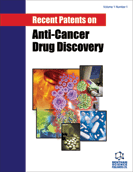
Abstract
Cancer is a common disease in Western society that can affect any organ system. It has a high morbidity and mortality despite advances in treatment over the last hundred years. There is a clear need for new approaches to cancer chemotherapy including the possibility of reducing systemic adverse effects associated with current treatments. Vesicle trafficking is an essential cellular process that is perhaps not fully recognized. There is mounting evidence that vesicle trafficking, including the release of extracellular microvesicles, is a highly important process in tumourigenesis. Diverse aspects of tumourigenesis including invasion, metastasis, cell cycle regulation, angiogenesis, tumour immune privilege, neoplastic coagulopathy and multidrug resistance can be explained by altered vesicle trafficking in cancer cells. This paper reviews the evidence in the scientific and patent literature for the role of vesicle trafficking in tumourigenesis and suggests a number of targets and strategies that may be important for cancer therapeutics.
Keywords: Vesicle trafficking, cancer, chemotherapy, multidrug resistance, vesicle, exosome, microvesicle, microparticle, membrane vesicle, exocytosis
Recent Patents on Anti-Cancer Drug Discovery
Title: Targeting Vesicle Trafficking: An Important Approach to Cancer Chemotherapy
Volume: 3 Issue: 2
Author(s): Paul K. Wright
Affiliation:
Keywords: Vesicle trafficking, cancer, chemotherapy, multidrug resistance, vesicle, exosome, microvesicle, microparticle, membrane vesicle, exocytosis
Abstract: Cancer is a common disease in Western society that can affect any organ system. It has a high morbidity and mortality despite advances in treatment over the last hundred years. There is a clear need for new approaches to cancer chemotherapy including the possibility of reducing systemic adverse effects associated with current treatments. Vesicle trafficking is an essential cellular process that is perhaps not fully recognized. There is mounting evidence that vesicle trafficking, including the release of extracellular microvesicles, is a highly important process in tumourigenesis. Diverse aspects of tumourigenesis including invasion, metastasis, cell cycle regulation, angiogenesis, tumour immune privilege, neoplastic coagulopathy and multidrug resistance can be explained by altered vesicle trafficking in cancer cells. This paper reviews the evidence in the scientific and patent literature for the role of vesicle trafficking in tumourigenesis and suggests a number of targets and strategies that may be important for cancer therapeutics.
Export Options
About this article
Cite this article as:
Wright K. Paul, Targeting Vesicle Trafficking: An Important Approach to Cancer Chemotherapy, Recent Patents on Anti-Cancer Drug Discovery 2008; 3 (2) . https://dx.doi.org/10.2174/157489208784638730
| DOI https://dx.doi.org/10.2174/157489208784638730 |
Print ISSN 1574-8928 |
| Publisher Name Bentham Science Publisher |
Online ISSN 2212-3970 |
 13
13
- Author Guidelines
- Graphical Abstracts
- Fabricating and Stating False Information
- Research Misconduct
- Post Publication Discussions and Corrections
- Publishing Ethics and Rectitude
- Increase Visibility of Your Article
- Archiving Policies
- Peer Review Workflow
- Order Your Article Before Print
- Promote Your Article
- Manuscript Transfer Facility
- Editorial Policies
- Allegations from Whistleblowers
Related Articles
-
The Metabolomic Strategy in Tuberculosis Therapy
Combinatorial Chemistry & High Throughput Screening Role of PPAR in Cardiovascular Diseases
Recent Patents on Cardiovascular Drug Discovery Molecular Cloning of a Novel PPEF-1 Gene Variant from a T-Cell Lymphoblastic Lymphoma Cell Line
Recent Patents on DNA & Gene Sequences Medication-Induced Acute Abdominal Pain: Evaluation with CT Imaging
Current Medical Imaging The Disulfide Analogues of Isophosphoramide Mustard for Anticancer Therapy
Letters in Drug Design & Discovery Repurposing some of the Well-known Non-steroid Anti-inflammatory Drugs (NSAIDs) for Cancer Treatment
Current Topics in Medicinal Chemistry Biosystems Engineering of Prokaryotes with Tumor-Killing Capacities
Current Pharmaceutical Design Metallothionein as a Scavenger of Free Radicals - New Cardioprotective Therapeutic Agent or Initiator of Tumor Chemoresistance?
Current Drug Targets 4,7-Dihydroindole: A Synthon for the Preparations of 2-Substituted Indoles
Current Organic Synthesis Group-sparse Modeling Drug-kinase Networks for Predicting Combinatorial Drug Sensitivity in Cancer Cells
Current Bioinformatics An Agathokakological Tale of Δ<sup>9</sup>-THC: Exploration of Possible Biological Targets
Current Drug Targets Surface Antigens/Receptors for Targeted Cancer Treatment: The GnRH Receptor / Binding Site for Targeted Adenocarcinoma Therapy
Current Cancer Drug Targets Pharmacogenetics Strategies: From Candidate Genes to Whole-Genome Association Analysis. Exploratory or Confirmatory Studies?
Current Pharmacogenomics and Personalized Medicine Modulation of the TRPV1 Channel: Current Clinical Trials and Recent Patents with Focus on Neurological Conditions
Recent Patents on CNS Drug Discovery (Discontinued) Honey, Health and Longevity
Current Aging Science The Role of Neuronal Pathways in Gastrointestinal Cancers: Targets for Prevention and Treatment
Letters in Drug Design & Discovery Relative In Vitro Potentials of Parthenolide to Induce Apoptosis and Cell Cycle Arrest in Skin Cancer Cells
Current Drug Discovery Technologies Concomitant CXCR4 and CXCR7 Expression Predicts Poor Prognosis in Renal Cancer
Current Cancer Drug Targets Antigene and Antiproliferative Effects of Triplex-Forming Oligonucleotide (TFO) Targeted on hmgb1 Gene in Human Hepatoma Cells
Anti-Cancer Agents in Medicinal Chemistry Furan-induced Oxidative Stress and DNA Damage in Diabetic and Nondiabetic Rats’ Blood and Protective Effect of Lycopene
Current Nutrition & Food Science


























